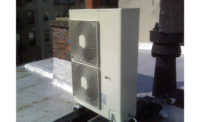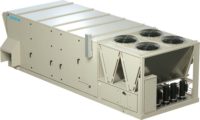Money and comfort are longtime rivals locked in a fierce battle to claim the upper hand when it comes to hospital and hospitality HVACR decisions. Joining them are the familiar contenders — sustainability and energy savings — as well as the new contenders — technology and controls. Wielded differently in each generation’s hands, these decision-making tools are shifting the marketplace and providing insight for contractors looking to vanquish their commercial customers’ doubts.
Armed with trend information and knowledge, contractors can provide effective and advanced quotes to their customers that expertly balance money and comfort. To the victor go the spoils, which, in this case, is a new hospital or hospitality account.
FLEXIBILITY AND MICRO HOSPITALS
Hospital construction and HVACR installations are changing as sustainability moves from a buzzword to a cornerstone of commercial buildings. Saving money and the environment while simultaneously providing comfort is often the goal of hospital construction accountants and engineers. The emphasis on verified energy savings and improved efficiencies are opening up purse strings for those considering the overall life cycle cost, as opposed to strictly considering the equipment cost.
“Decision-makers are looking at the ROI [return on investment],” said Mark Kearschner, vertical market lead, Healthcare, Daikin Applied. “They are scrutinizing what they are getting for their dollar. The systems have to have the flexibility to meet all the needs of a facility, whether it’s five or 10 years down the road.”
When referencing the flexibility of the HVACR system in a commercial capacity, Kearschner warned contractors that open protocol systems play a large part in the future of hospital HVACR.
“For so many years, health care and large buildings in general have been held hostage by some of these control systems with proprietary language,” he said. “They are looking at add-ons down the road, and flexibility is paramount to them.”
These add-ons are a priority to many customers due to the increasing advances in technology. According to Kearschner, there is a technology upgrade every 18 months, which can be a hassle for both the contractor and the customer. The situation is causing customers to ask questions in an effort to differentiate between slight improvements with a new coat of paint and true technological advances.
“When I worked in the hospital and I needed a chiller, I would look to see what kind it was and then tell the contractor to give me another one just like it,” he said. “Now, customers have a greater awareness of what they are getting their hands on; and with new variable plants, chillers, VFDs [variable frequency drives], and such, it’s a whole new game. It takes a lot of time to put something like that together. It’s not just grab and replace a piece of equipment anymore.”
Moving away from the large 1,200-bed hospital construction projects, new medical structure construction is concentrating on downsizing to satellite regional care facilities. The facilities will provide urgent care and certain medical tests, but the more expensive technology needed to conduct other medical tests will only be available at the main hospital branch.
“Because of the way the hospital industry is shifting, it cuts down the cost of construction and still meets the needs of the consumer,” said Kearschner. “But it reduces the cost to the hospital, and it allows them to put the money into greater capital improvements and better HVACR equipment.”
EARLY UPGRADES
The medical community is currently shifting toward newer HVACR technology as a result of the increased adoption of natural refrigerants. Although not currently mandatory, the early use of natural refrigerants in hospitals is seen by Embraco as necessary in order to maintain proper operation.
“Due to the type of products being stored in medical refrigeration, suppliers to the medical community typically take a long time to certify changes — anywhere from six months to a year,” said Jason Bradford, sales engineer, Embraco. “They have to be careful that whatever changes they make won’t reduce the reliability or the quality of the biological product.”
Found in hospitals, medical labs, and research facilities, refrigeration is necessary for some medicines, vaccines, specialized experiments, and diverse biological materials used in the practice and study of modern medicine. The special cargo and extended timeline provide contractors with an opportunity to help hospitals replace their older technology in advance. This not only provides reliability to the hospital and its biological materials, but it also allows for increased efficiency through upgraded compressors and subsequently decreased operational costs.
“If you think about it, some of these hospitals have hundreds of refrigerators storing different medicines for their patients and on several floors,” said Bradford. “Looking at the energy footprint of that building, especially in regard to those refrigerators, that is a lot. Anytime that they can reduce the overall cost of their energy, they can end up reducing the overall cost to the patient. It has a trickledown effect.”
LESS EXPENSE, MORE COMFORT
Hospitals aren’t the only 24/7 establishments making changes. Hospitality venues like hotels are seeing a change in trends as well, especially as the millennial generation continues to demand sustainability. What started as a tag on the bathroom counter explaining that guests can participate in conserving water by reusing their towel has become a movement demanding efficiency, amenities, and comfort with an environmental conscience.
“Sustainability is being taken more seriously,” said Steven Horowitz, director of business development at Optimum Energy. “I think everyone out there understands that going green can produce green. It can be good both for the customer and for their bottom lines.”
According to Horowitz, hotel owners are concerned about guest comfort and perceive expense as a challenge to that goal. They have a tendency to exchange lobby remodels as opposed to purchasing new HVACR equipment. Using controls and connectivity, however, can help remove the perceived issue of comfort equaling unaffordable expense. Horowitz suggested that those running hotels take advantage of the controls that can be used from building automation as well as software optimization in order to provide both energy savings and improved comfort.
“You don’t have to give up guest comfort for efficiency,” he said. “You don’t have to give up being able to spend money on the things the guests can see, like the pretty lobby and the nice hallways, in order to afford efficiency.”
Contractors have a role in this conversation with hotel owners. Once they have learned about different solutions and partnered with the companies providing their solution of choice, a new world of connected, efficient, and advanced buildings can provide new revenue streams.
“Hotel owners can have their cake and eat it too, so to speak,” said Horowitz. “Any contractor interested in partnering with us certainly has that option.”
Publication date: 12/17/2018
Want more HVAC industry news and information? Join The NEWS on Facebook, Twitter, and LinkedIn today!











